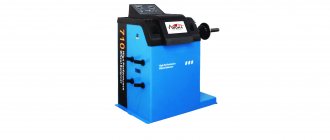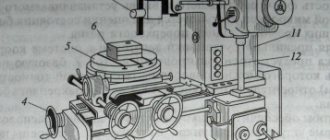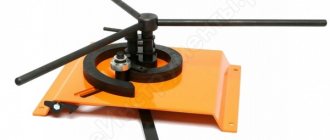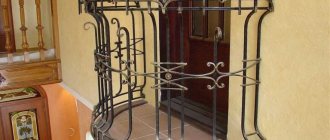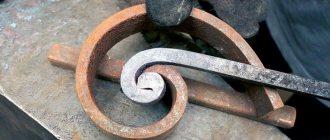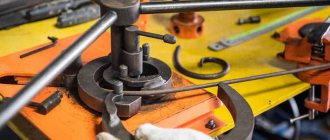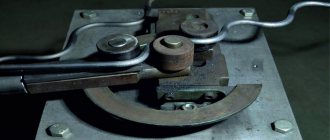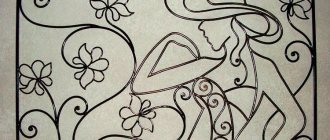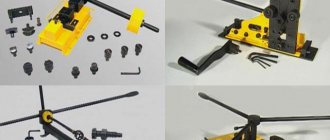Metal products made using forging have long become very popular due to their beauty and sophistication. Such decorative elements are quite expensive and it is not always possible to order all the desired decorations for your interior or country house. But, in addition to the hot type of forging, which is needed in order to create metal decorative structures, there is a cold variety. The last option can be implemented independently; for this you will need to build a cold forging machine with your own hands, after which you can begin to implement all your plans and ideas.
DIY hodol forging machine
- 1 Types of machines 1.1 Video on making a machine for cold forging with your own hands.
- 2.1 Video review of a manual machine for forging metal
- 6.1 Video instructions
Types of machines
Basically, all devices that are intended for the manufacture of metal parts using cold forging are characterized by a manual drive. Few of them operate on the electric drive principle, although such a structure can be built with each of the devices. The only question regarding the drive is its feasibility, because the cost of the energy resource that powers the unit and the complexity of the installation process of the mechanism may not be justified if they are correlated with the amount of work performed and its regularity.
The table shows all the devices that operate using a manual drive and are related to the cold forging process.
| Device | Short description |
| Twister | With the help of such a device, the metal is twisted, spirals and curls with a narrow core are formed. |
| Torsion bar machines | With the help of such a machine, screw-type rods are twisted, and it is also possible to produce large spirals and filaments (baskets, lanterns and bulbs). |
| Inertial stamping machines | They are intended for making connecting parts with decorative components, making patterned tips and various small patterns and reliefs. |
| Bending machines | There are several types of such machines: push, broach and combined types. The first variety is needed in order to obtain wavy bends or to bend a rod in a zigzag manner. The extended variety is in demand when it is necessary to make a ring, curl or spiral with a wide core. Using the combined variety, you can build any of the listed elements. |
Help: very often in some sources you can find the name of machines designed for torsion as well as for machines that do winding - twisters. However, this is not entirely true; machines that twist metal are torsion bar machines.
Video on how to make a cold forging machine with your own hands.
Purpose of forged products
Do-it-yourself artistic forging has firmly taken a leading position in the modern market. These products can be found not only on fences and gates, but also on beds in ordinary apartments. There are several types of products where forging is used most often:
- Gates.
- Fences.
- Lattices.
- Stairs.
- Gazebos, barbecues.
- Furniture and its accessories.
Due to such a great demand for forged products, one can’t help but wonder why people like elements of artistic forging so much. After all, metal is a cold, heavy material that is susceptible to corrosion in the environment. In contrast to these negative factors, there are many favorable ones:
- Durability.
- Exquisite beauty.
- Increased protective functions.
- Possibility of production according to any dimensions and sizes.
- Full possibility of imagination in manufacturing.
- Forged products combine well with other materials.
And this is not the entire list of advantages of forged elements. If we combine all the above expressions, then metal objects are durable, strong and very beautiful products.
Differences of cold forging
There is such a thing as “stamping”, which is sometimes confused with the cold type of forging. Cold forging itself has 2 principles according to which this process can occur. The table shows the differences between the processes.
| Process | Description |
| Stamping | The stamping process can be described as the extrusion of certain shapes using a punch that operates at a high level of pressure. An example of the stamping process is an aluminum can. Heating of the metal is not used in this case. The ability to apply such technology at home is hardly possible, since it is impossible to create the necessary conditions for this. |
| Cold forging type (riveting) | This type of cold forging, in essence, is cold hardening, namely, a certain number of blows of very high force are carried out in the process, which allows the structure of the metal to change and become the required parameters in size and shape. This manipulation is carried out using a hammer, which you can also build with your own hands. |
| Cold forging type (bending) | Another type is bending. With this technology, the metal structure remains the same without changing its characteristics. This type of forging can be used at home; all you need to do is create a cold forging machine with your own hands. |
Cold forging, which is carried out on the principle of bending, is quite simple to do, especially if you have special stationary equipment that significantly facilitates the process. The advantage of this variety is that you can assemble almost any cold forging machine with your own hands without much expense.
Video review of a manual machine for forging metal
Wave and zigzag
How to make a cold forging machine, through which it is possible to create wave and zigzag elements? To do this, you will need rollers made of tool/chromium-nickel steel. Limiters are placed in the arc, making it possible to create an accurate wave profile.
If you install a special gate on the snail, you can create waves. The handles are the same. They are screwed into the threaded sockets on the gate head. It is recommended to place the main roller separately and attach it to the base with head bolts.
Forged products must be combined into one whole. The easiest way is to weld and then smooth the seams with a grinder and a grinding wheel. It is thicker than cut-off and copes with bending forces. Parts that are connected with shaped clamps look much better. Stamping is carried out from a strip of one and a half millimeters. The clamp blank is made in the shape of the letter “P”. Her wings are bent from the back using a hammer. Special enamels and paints for metal products are used for painting. Enamels with pigment are more expensive, but they are not prone to peeling, fading, wear and thermal deformation.
The loads endured by a cold forging press, especially impact loads, are quite high. This requires precise processing of the workpieces. In view of this, it is better not to try to make such a device using a drawing of a cold forging machine. You can only make a manual rolling mill yourself. However, steel rolls, shafts and bearing bushings will still need to be purchased.
If you seriously intend to take up blacksmithing, try making a twister or torsion device. The drawings of a cold forging machine are quite simple; even a person who is very vaguely familiar with blacksmithing can understand them. You can find machine drawings on the Internet or ask friends who are involved in blacksmithing. Of course, the profession of “blacksmith” today is less popular than the same “conductor”, but this does not mean that no one is engaged in blacksmithing at all.
Manual machines for cold forging can be bought ready-made, or you can assemble a forge with your own hands, purchasing or making everything yourself. Purchased equipment, high-performance and expensive. For a small workshop, the second option is more suitable.
The main areas of cold forging are fences, gates, window grilles; some prefer artistic forging and feel like metal designers.
Since a furnace is not needed for cold forging, the only tools needed are an anvil and a hammer. Materials: hot-rolled steel: square and round profiles of various sections, sheets.
For artistic forging, you may also need some non-ferrous metals. Before starting to manufacture a product, you need to have an idea of its final form, in addition, it is advisable to have a life-size drawing or stencil.
Equipment for cold forging allows bending, cutting, riveting, and making holes. Conventionally, the technological processes performed on them are divided into two types: bending and twisting.
The most common devices are: Gnutik, Twister, Snail, Globe, Wave and Flashlight.
Construction of cold forging machines
Each device for cold forging has its own characteristics and parameters. In order to easily make a cold forging machine with your own hands, you need to understand what each of them is.
| Machine | Device | |
| Bending machines | The design of this device is such that by changing the rollers and wedges, the size of the waves and bends changes. They can bend rods up to 16 mm. The only caveat of this device is that it cannot be made independently, because it requires processing and turning many parts of the exact size. The cost of such a device is low. | |
| Twister | The unit works by equipping it with a special template, onto which the piece of metal being processed is pressed. The pressure must be very high, so those who work on the twister must have sufficient strength to do this. In addition, the safety of the template itself is ensured by the presence of a persistent horn (end). As for the middle horn, which is otherwise called the encircling horn, it should be made in such a way that it can change its position and be fixed in it. The efficiency of work depends on this, especially for those who are starting the process for the first time. | |
| Base with spacers | This unit will allow you to make patterns of absolutely any variation. The design itself is very simple and consists of a plate made of durable and reliable material into which spacers are screwed at a certain distance. For such purposes, you can use bolts with sizes from m8 to m24. The thickness of the metal depends only on the skill of the person working on the machine. Basically, this device is well suited for metal with a thickness of 6 mm. | |
| Snails Twister machine | With collar | This installation consists of a base plate on which a special coil is located. This coil is used as a template for the future product. The peculiarity of the machine is that the “snail” template is divided into several parts, which are secured to each other using special connecting elements, which allows the template to vary in shape during operation, which creates various kinds of waves and bends. There are also disadvantages to this design, since in order to make such a machine for cold forging with your own hands, you need to select a very durable material that will not bend over time. Also think over the connecting loops, which are quite vulnerable, given the amount of force with which the entire process of bending the metal occurs. |
| Lever type | In this type of snail machine, the template is attached very firmly to the base. Due to this fact, its productivity is lower, however, its reliability is greater. Using a special lever, the metal plate is pressed against the template; at the same time, the movable roller must be moved during the process. To make such a machine for cold forging with your own hands, you can use steel material, which is distinguished by its strength, and the roller can be made from a regular roller bearing. In general, the design is similar to a pipe bender. | |
| Torsion bar machine | Such a device will be good for screw twisting rods. Such a machine is made from a cylindrical metal base and two fastening and simultaneously twisting elements. It is advisable to equip such a structure with a special pair of paws that will not allow the metal being processed to bend in ways that are not necessary. The principle of operation of the machine is such that the rod is placed in the elements holding it, clamped at one end, and at the other end, using a rotating spindle, it is twisted to the desired size of the helical wave. | |
Kinds
Industrial forging without heating the workpieces uses special tools and equipment to produce large batches of products. Metalworking includes the following technological operations:
- flexible;
- calibration;
- firmware;
- tenderloin;
- stamping;
- winding
The tools used are stamps that allow the production of exactly identical parts in large batches, and powerful presses.
For the manufacture of bars for windows, gates, and furniture, rods with a cross-section of 8–16 mm and sheet strips are used. Products are assembled from elements made by hand according to a template.
Elements of a forged fence and balcony railing are connected to each other by welding and placed in a strong frame or attached to a reliable base. The design is made flat or three-dimensional, depending on the master’s intentions and purpose.
Lattice on the window
Equipping a torsion bar cold forging machine with an electric drive
In order to increase not only the efficiency of work on a cold forging unit, twisting rods into a helical wave, but also to increase the speed, as well as ensure stability and not be subject to overfatigue, you can install an electric type drive.
Working by hand, it is quite difficult to make all the decorative elements made of metal rods the same, since the uniformity of the rotational moment in such a situation will vary greatly. In order to avoid errors in the manufacture of products, you can use:
- axle shaft from the car, which is installed on the drive axle;
- you will also need a differential gear pair;
- For protection it is worth using a casing.
From the listed devices you can build an electric drive for a torsion bar machine. It is better for such an engine not to exceed power ratings of 900 rpm and 3 kW.
Twisters
Since ancient times, blacksmiths have cold-formed curls according to a template-mandrel using a horn lever grip, pos. 1 in Fig. This method is low-productive and not for wimps, but it allows you to quickly and easily make various bending mandrels from an ordinary steel strip: the end (thrust) horn of the lever prevents the template from yielding under the pressure of the workpiece. It is advisable to make the middle (bypass) horn sliding with fixation: the work will go slower, but, especially in inexperienced hands, more accurately.
The simplest devices for cold artistic forging
Another simple device for manual shaped bending is a strong board with support pins - spacers, pos. 2; Ordinary M8-M24 bolts are suitable. Depending on how friendly you are with your home exercise machine, you can work with a strip of up to 4-6 mm. They bend the strip by eye, the work goes slowly, but you can draw patterns up to Ilya Muromets on a horse in full armor or Buddha in a lotus flower. The latter, perhaps, is completely handmade: people who have fully mastered hatha and raja yoga are able to curl steel reinforcements into a pattern with their hands.
Building a curl for the machine with your own hands
Before you start creating a cold forging machine with your own hands, you need to be able to calculate the parameters of a template spiral, because there are practically no special programs for such purposes. Such a template should not only be technically competent, but also have an attractive appearance.
The calculations for this pattern are based on a logarithmic spiral. Some nuances during construction can be highlighted in the following list:
- the beginning of the construction is taken at point R0;
- the turning radius will be equal to a fixed angle;
- the length of such an angle must be multiplied by the divergence of the coil;
- the discrepancy in the standard version is generally taken to be 1.2;
- for simplicity of calculations, as well as maintaining accuracy, the bending angle is best taken at an angle of 45 degrees;
- if there is a need to build a template that will have a denser spiral, then the 8th part (s) of the unit distance from the spiral should be added to the radius;
- As for r0, it must be equal in cross-sectional size to the diameter size of the workpiece for the spiral.
Important: r0 can take any value, it all depends on what characteristics the metal is used for the workpiece, namely its density.
Taking into account all the nuances, you can start making a “snail” template; for this, it is best to be able to solve equations that have a cubic degree and higher. There is no exact formula for calculating such a device, but there is one that allows you to achieve the optimal result. The sequence when constructing a spiral template can be like this:
- the initial point r0 is determined first;
- the turns that the template will have are taken arbitrarily, their number can be any;
- using tabular data, you should calculate the diameter (b), while ensuring that it is smaller in width in the opening for the template;
- using the formula, the radius R is calculated;
- the last step is to transfer all the obtained points in accordance with the scale, after which you can proceed directly to construction. In the process, let’s adjust the radius R in the final version using a similar formula.
Help: if it becomes necessary to calculate intermediate values, then this is done in accordance with the geometric proportion.
How to manufacture and assemble individual machine components and tools for it
As an example, step-by-step instructions are given for obtaining the “Twister” device, which is intended for uniaxial longitudinal twisting of a steel workpiece from a bar of square cross-section. Similarly, and in the same sequence, operations will be performed on other parts of the cold forging machine - volute, core, template, bend, etc.
The supporting workpiece for this device should be an I-beam or a channel with thick flanges. A wide thick sheet strip is welded to it, to which a bench vice can be attached. The stationary part of the twisted rod will be clamped in them. The vice should be secured especially securely - using at least four bolts with a diameter of M16 or more. To increase the clamping area of the rod, corrugated plates made of thick sheet steel are welded to the jaws of the vice. At the opposite end of the I-beam, guide rollers are installed, to which a clamping unit for the moving part of the workpiece will subsequently be attached. It can be made from a steel bushing, along the generatrix of which it is necessary to provide three holes located at an angle of 120° for clamping bolts with a diameter 2...3 mm smaller than the side of the square of the element being twisted. The bolts must be hardened, made of high quality steel, and also have a flat end. Both clamping devices must be positioned coaxially, which is checked using a level, a bench square, or a caliper.
Next, a handle is made to rotate the movable part of the clamp. The lever under it must be provided as long as possible - this way the value of the applied force will be reduced. At the same time, the length of the lever should be comfortable for the user. It is better to select the handle itself from the standard ones, and preferably with a rubber bushing - to eliminate the possible slipping of the hand of the operator of the cold forging machine when performing the corresponding plastic deformation transition on it.
After assembling a cold forging machine, it is checked for the reliability of movement of moving elements, as well as for the accuracy of operations for plastic deformation of metal. After this, you can make the final fastening of the device to the support frame.
Construction of a cold forging machine
When drawing up a drawing to further create a template for the machine, it is best to make sure that it has the maximum number of different variations regarding bends and waves. Having such blanks, you can create a cold forging machine with many interchangeable attachments, which will make it possible to produce various patterns and monograms.
Sequence of actions when creating a device:
- Initially, you will need a metal sheet, the size of which will depend on the number of patterns placed on it. The templates themselves should be placed in such a way that there is room for the manufacture of products, because during the process the material from the nozzles may shift due to lack of space. Also, if the templates are not sufficiently spaced from each other, complications may arise in the work.
- As for the variations of the templates themselves, they can be either simple or contain more than one turn of the monogram. You can make a similar ploughshare-type snail and think through the design of the bends in the disassembled and assembled state. At the same time, you should be careful when selecting the material for fixing the sliding parts - it should be as durable as possible.
- The change of nozzles can be ensured by making a rectangular slot; replaceable templates for forging can be inserted into it. They should all be attached to metal plates shaped like a rectangle. Fastening of such nozzles will be ensured using bolts.
Video instruction
Tricks of the Masters
The use of spacers allows for an instant change in the shape of the final structure or making bends in the opposite direction, which the plowshare does not allow for structural reasons.
Does not require increased precision in the manufacture of parts.
Fastening the workpiece is as easy as shelling pears – place it in a special recess.
Allows the use of a technique that is used in industry - a slight bend in the opposite direction in the core of the curl.
It is possible to use different techniques and bends in forging
Such cold forged products look better and are more expensive.
Additionally, it has a good and convenient advantage - the ability to produce flat bends with a thin core from a workpiece lying flat.
The lever machine allows the installation of a clamping roller at a height of strip thickness and a flange wider than a railway wheel. This method requires painstakingness: the lever must be moved little by little, otherwise the inner edge will be damaged. Unfortunately, this is the only method for making such curls in DIY production.
A machine with a lever is often created without the use of rare or expensive materials and without having accurate diagrams.
Assembling the device
This version of the machine is used as an example because of its simplicity. Knowing the basic principles and sequence of equipment design, you can upgrade it at will. To assemble all parts of the equipment into a single whole, you will need to use:
- drill with carbide type drills;
- welding machine;
- a saw cutting metal or a hacksaw;
- metal sheet of the selected size;
- round metal pipe;
- metal rod;
- bearings of different sizes;
- bolts size M8.
To assemble a cold forging machine with your own hands, you need to use a proven sequence of actions:
- Initially, you need to assemble a stand that will serve as a support. To do this, all its components (pipe sections of the same size and the joints between them at the top and bottom edges) must be connected into a single whole. The design may resemble a stool in appearance. The connection is made using a welding machine, and the sections are cut with a saw.
- The next step is cutting the metal sheets. You should get circles of equal diameters and four triangles with equal sides. Triangular-shaped elements must be welded to the bottom of the connected pipe structure in such a way that something similar to a pyramid is formed. The base, which has a wider area, must be welded at the central point of the cut circle.
- Four strips that are located horizontally must be attached to a circle with an already welded element. This should be done using bolts; for this you will need a drill to make the holes.
- The next step is the construction of the handle. To do this you need to use two rods of different lengths. Their sizes can be determined by correlating them with the diameter of the circle. One rod should be commensurate with the diameter, the other should slightly exceed its size. When bending the first rod, you should maintain an angle of 30 degrees. Then weld both rods to each other, and then weld another rod into the lower part. There should also be a jumper between the first two sections, to which a lever is attached by welding, which should maintain the direction towards the structure made of rods.
- A bearing for future directional variability in the device must be attached to the end of the attached lever, as well as to the segment located at the bottom of the structure. The upper section serves as a mount for a metal coil, which must be installed horizontally - it makes it possible to bend the metal. On the lower side of the segment, where there is a free end, a hole should be made equal in diameter to the size of the pipe section.
- The last step in the algorithm of actions when constructing a machine for cold forging with your own hands will be the connection of the designed handle with a part of the device similar to a “pyramid”. These elements are fixed after putting on the handle with a wide-diameter nut, to which it is first necessary to weld a metal circle, which will allow the template itself to be attached to the machine. Next, the “snail” template is attached by welding.
Conclusion
Anyone who decides to take up forging seriously and make a cold forging machine with their own hands should be very scrupulous at the stage of creating drawings and calculations. Otherwise, the creation process is quite simple, and once you understand the principle of equipment design, you can come up with various variations of it that will help improve the product.
Homemade “Snails”
In essence, this is a modernized bending machine (pipe bender), but these improvements make it possible to easily make curls from fairly thick rods (up to 10-12 mm cross-section) and repeat them with a high degree of accuracy.
One of the homemade cold forging machines
These cold forging machines have several designs, but the easiest to implement is the one with a round table with a central leg. A lever with rollers on bearings at the end is movably attached to the leg. They make the bending process easier.
The table surface can be made of steel sheet with a thickness of 10 mm or more. For the leg, you can use any thick-walled round pipe. It is important to make the structure stable, since lateral forces will be applied, so side posts, spacers, and a stable base are needed.
Drawing of a cold forging machine “Snail”
It is easier to make a lever from a square pipe with a thick wall - at least 2-3 mm. The cross-section of the pipe is 25*40 mm or so. Attaching the lever to the leg can be done on a bearing, or you can simply take a small piece of thick-walled pipe of a larger diameter, put it on the leg, and weld a stop strip on the bottom so that the lever does not fall down. The option with a bearing gives easier movement, but if there is lubrication, the second option also works.
Lever mounting option
The shape of the lever is also important. The lever is double, the upper part is working, the lower part is supporting. Wherever there are connections, it is advisable to add reinforcement, since the efforts are significant.
The lever must be reliable, with reinforcement
A mandrel or jig is fixed on the table - the shape along which the curls are bent. They are made in different diameters so that you can make curls of different diameters. Such mandrels can be prefabricated to form a larger number of bends. Each such sample must have rods that are installed in holes in the table. This is how this template is fixed. Also, its shape must be designed in such a way that the end of the rod is well fixed in it.
Variant of conductors for the snail
Often, mandrels are machined from a metal circle of a suitable diameter using a grinder, but there are options made of metal with steel plates welded onto it, curved accordingly.
How to make a similar machine for cold forging is in the next video. There is also a good description of how to bring the ends of the workpiece to a decent state - ordinary raw edges look very rough. There is special equipment for processing them, but, as it turns out, you can do it without it.
Home workshop - equipment, equipment, placement
Forging at home, if we are not talking about creating only a beautiful barbecue or flower stand, will sooner or later require the creation of special conditions for comfortable work. Even to practice forging as a hobby, you will need a large, well-lit room, where, in addition to the machines, you will need to provide space for both an editing table and a painting module, as well as select a minimum set of tools for the work.
Tool set for cold forging workshopSource instagram.com
There are many arguments for selecting a spacious room, but when planning placement it is worth taking into account:
- cold forging of a profile pipe requires first rolling the profile so that it can be more easily shaped into a curl or snail. To do this, the rollers must be placed so that the length of the room is 2.1-2.5 times greater than the pipe section.
- the snail machine must have access from all sides;
- for large-scale work, for example, for assembling fences or entrance gates, the assembly table should be made so that it is 0.2-0.3 meters larger than the structure;
- machines must have a massive frame and reliable fastening to the floor, but the assembly table can be made according to the transformer principle - they must be mobile and fold up quickly.
An important detail of home workshop equipment is what set of templates the machines will be equipped with. For an entry-level workshop, a snail for forging should have 2-4 templates, from a small one of 10-12 cm in diameter to a maximum of 18-20 cm
A machine for twisting profile pipes, in addition to the most common pipe size of 25x25 mm, should be supplemented with templates for large diameter pipes up to 40x40 mm inclusive.
Homemade twister machine for making flashlights and twisting a profile pipeSource pinimg.com
Rollers for rolling, in addition to the usual flat shape, must have shafts for working with both profile and regular round pipes. For a press, you need to have several molds to work with sheet metal. Here you will need forms for stamping leaves, petals, hemispheres and decorating the ends of profiles.
Basics of work activity
Various bending techniques: a, b, c – using substrates; g – in a fork; d – on a bending plate.
After the owner assembles the conductor himself, you need to make sure that it is in good working order, convenient, and that it can perform the task with the utmost quality. Those. All 3 mechanisms are described, each of them requires its own unique approach. A 10 mm rod will be used everywhere:
- The platform is attached to the selected location. Then the rod is fixed between the holder rod and the strip so that there is no free play. Now the hand that is more convenient to work with is selected and a slow rotation begins. After 1 revolution the platform changes and work can continue. If there is discomfort in the work, then you should try to make another snail, directed in the opposite direction, and then start all over again.
- The rod and platform are fastened in the same way, but the rod is already completely fixed, i.e. when working with your hands, you do not need to touch it, and at the same time there are no health risks. When rotating with a handle, the workpiece moves extremely slowly, but this will allow you to make the most rounded bend without defects. Stops will only be needed to add 1 more spiral element.
- The electric motor will do everything itself, but it needs to be stopped periodically to extend the spiral. The only unpleasant aspect of the operation is paying for electricity, but, as a rule, electric motors do not consume too much current. The presence of levers for manual work allows you to level out this problem in certain situations.
The whole process is always carried out extremely slowly, and the work is carried out with thick gloves. Despite the malleability of the rod, there are situations when the metal bursts. In such cases, you just need to be prepared to remove the defective workpiece and continue working without loss of time and health.
About the way of operation or control
The mechanisms are either manual or electric. The first option is suitable for beginners. They can create parts of the same dimensions without constant retooling. Electric motors, on the contrary, place greater demands on the skills of the operating master. But such options differ in productivity and ability to work with large-format workpieces.
How to bend a profile pipe on the “Snail” machine?
If you try to bend a profile pipe without special preparation, the weld will come apart. It will be a marriage.
Blacksmiths with extensive experience make more complex machines to make their products. They additionally equip the “Snail” with removable elements.
